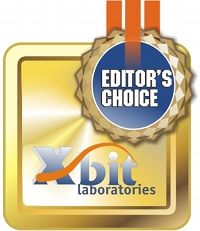ASRock Z77 OC Formula Review: LGA 1155 Mainboard for Overclocking and Breaking Records

The long list of various peculiarities and features of this mainboard should make overclocking and performance optimization very easy. Free from any major issues, this award-winning product is definitely worth your attention.
Just like other leading PC mainboard makers, ASRock didn’t stop after announcing a large line-up of products at the time of Intel seventh series chipset launch. The company continues to regularly roll out new mainboard models with different feature set and different prices, trying to ensure that they have all user groups covered. In the beginning of our review series we introduced to you two ASRock mainboards – Z77 Extreme4 and Z77 Extreme6, then we reviewed ASRock Fatal1ty Z77 Professional, and after that we tested ASRock Z77 Extreme9. These models differ quite noticeably from one another, but they do have one thing in common: all of them overclocked our processor and memory to their maximum without any problems. However, even though ASRock mainboard didn’t have any problems with overclocking, the company decided to come up with a special mainboard dedicated solely to overclocking – ASRock Z77 OC Formula.
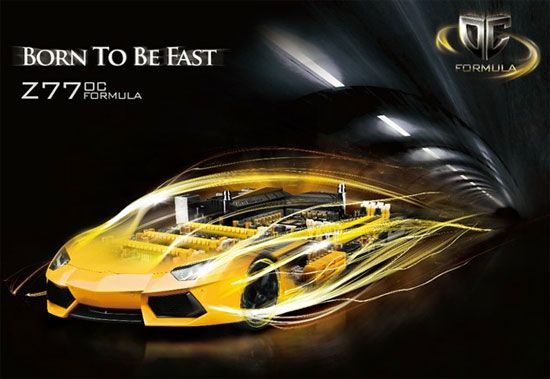
When the company engineered this product, they received assistance and recommendations from a famous overclocker – Nick Shih. We have already talked about special overclocker products from other mainboard makers, therefore, it is particularly interesting to see what ASRock has come up with, and how this mainboard is different from regular mainboards as well as competition.
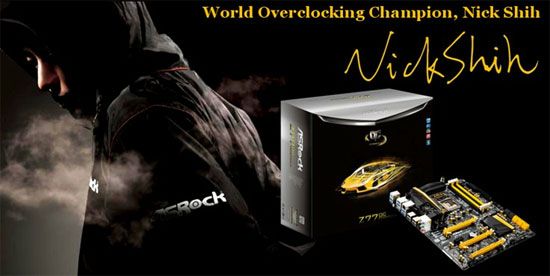
Packaging and Accessories
ASRock Z77 OC Formula mainboard comes in a very large box. The front of the box doesn’t bear too much information. There you will find just the mainboard model name, its image in the form of a race car and a few logotypes. However, you can open the top flip-cover attached with Velcro pads and see detailed description of the mainboard functionality inside. By the way, the box is rectangular. I am specifically stressing this aspect, because the design of the package is so sophisticated, that it may seem the package is of a convex shape.
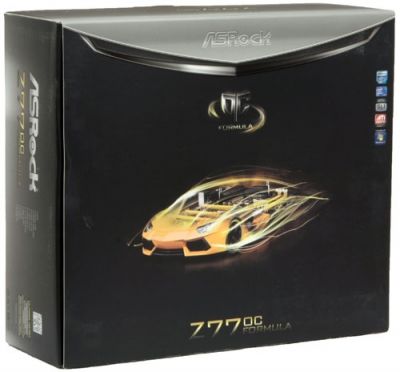
When we describe mainboard packaging, we always refer to relative characteristics, like big or small, thick or thin cardboard. Of course, it is not that hard to measure the box and provide its exact dimensions, but these numbers do not really matter, that is why we never actually do it. However, the sticker on ASRock Z77 OC Formula box gives us a good idea not only of its impressive size, but also of its significant weight.
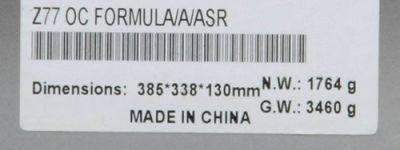
The mainboard is additionally protected with a composite casing of soft polyurethane foam material, and beneath it there is a two-section packaging for included accessories. The smaller section contains manuals. Inside the larger accessories section you won’t find a pile of parts, but a soft velour draw-string bag with “OC Formula” on it. All the accessories are neatly arranged inside this bag and include the following items:
- Six Serial ATA cables with metal connector locks, half with L-shaped locks and another half – with straight ones;
- Two power adapters for SATA devices;
- A hard bridge for Nvidia SLI graphics configurations;
- A module with two USB 3.0 ports, a rear panel bracket and a set of retention screws;
- A syringe with GELID GC-Extreme Thermal Compound;
- I/O Shield for the back panel;
- OC Stands for an open testbed setup;
- A brochure about the functionality of mainboard BIOS and accompanying software;
- User manual in multiple languages;
- DVD disk with software and drivers;
- ASRock OC Formula sticker for the system case.
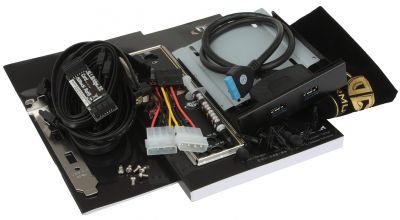
We have already pointed out before that ASRock mainboards are bundled with a very convenient universal module featuring two additional USB 3.0 ports. This module is originally designed to be installed into the free 3-inch bay of your system case, so that you could have two USB 3.0 ports on the system case front panel. If there are no empty bays available, or if the new case already comes with the front panel USB 3.0 ports, then you can use the enclosed bracket to add these ports to the back panel. However, until today we haven’t really paid attention to the fact that the module also has a special metal plate with holes in it, which can accommodate a 2-inch drive, and there is a corresponding set of screw included with the accessories. As for other quite common accessories, we have to mention that ASRock Z77 OC Formula now comes with a system case sticker, a syringe with high-quality GELID GC-Extreme thermal compound and a set of feet called “OC Stands”, which will come in very handy if you intend to use ASRock Z77 OC Formula in an open testbed setup.
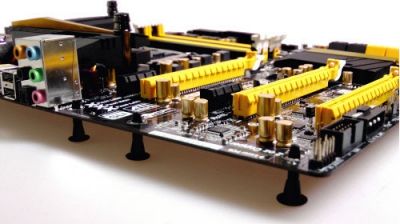
PCB Design and Functionality
The component layout on ASRock Z77 OC Formula is close to classical design versions, but if you take a closer look at it, you will notice a lot of unique peculiarities.
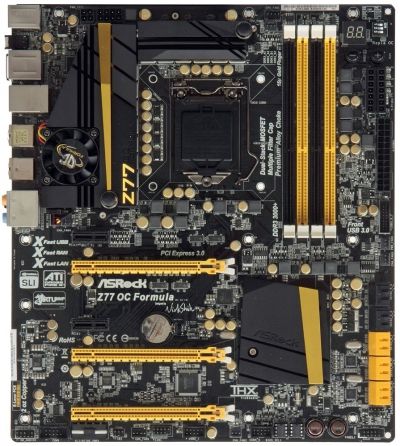
To begin with, let me say that the digital “DIGI Power” voltage regulator circuitry works as 12+4 phases and uses very high-quality components: Dual-Stack MOSFET (DSM), Premium Alloy Chokes (PAC) and Multiple Filter Capacitors (MFC). The components that run warm during operation are topped with two large heatsinks fastened using reliable screw-on retention. There is also an additional L-shaped backplate on the bottom of the mainboard PCB that provides additional heat-dissipating surface. The efficiency of this cooling system is further improved by a 40 mm fan with adjustable rotation speed. Moreover, you can connect these two heatsinks to the liquid-cooling contour, because they also have two fittings covered with plastic caps. This dual-purpose air-liquid cooling system even has its own special name – Twin-Power Cooling. The processor is powered via two standard ATX12V connectors – one eight-pin connector and one four-pin connector. The board uses a 2 oz copper eight-layer PCB, and the pins inside processor socket as well as inside the memory DIMM slots are plated with 15-micron layer of gold. For Ivy Bridge processors the range of supported memory frequencies starts at 1066 and ends at 3000 MHz. The available four DIMM slots can take in up to 32 GB of DDR3 SDRAM.
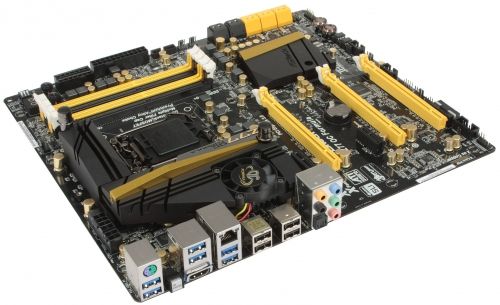
Intel Z77 Express chipset provides the board with four SATA 3 Gbps ports (black connectors) and two SATA 6 Gbps ports. Two additional Marvell 88SE9172 controllers add two more ports each and thus increase the total number of SATA 6 Gbps ports to six (yellow connectors). Two top PCI Express 3.0/2.0 x16 slots supports AMD CrossFireX and Nvidia SLI graphics configurations and share 16 PCI-E lanes. The third PCI Express 2.0 x16 slot has four lanes at its disposal thanks to the chipset. Besides this slot, there are two more PCI Express 2.0 x1 slots for other expansion cards. To ensure that all controllers and slots will not interfere with one another the board is equipped with PLX PEX 8605 hub that adds another five PCI-E lanes.
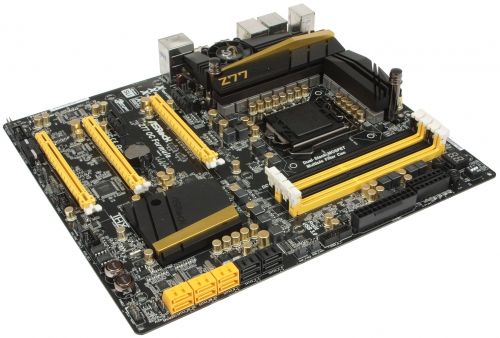
The graphics card slots have small and not very convenient latches, but the ability to disable any of the three PCI Express x16 slots by simply flipping a special switch somewhat compensates for this inconvenience. Moreover, there are also V-Probe voltage control points, a POST-code indicator, glowing Power On, Reset and Clear CMOS buttons and two Rapid OC buttons. They help adjust the base frequency, processor clock frequency multiplier and CPU Vcore on the fly, but they will only work from Windows OS and only once you have installed a special utility. We are going to talk more about this feature later in this review, as well as about the Multi Thermal Sensor – a variety of additional sensors that allow controlling the temperatures in different parts of the PCB. The mainboard has eight fan connectors, two of which are designated for processor fans. One of these fan connectors is a four-pin and another – a three-pin connector, and they allow adjusting the fan rotation speed in either case. There are two BIOS chips onboard, but we only work with one of them: the other BIOS chip is a reserve chip used to restore the primary BIOS in case of failure.

The photo of the mainboard’s back panel also shows the backplate at the bottom of the PCB. These are the ports and connectors you will find on the back of the board:
- Universal PS/2 connector for keyboard or mouse;
- Six USB 3.0 ports (blue connectors), four of which are implemented via EtronTech EJ188H controller, and two more ports are supported by the Intel Z77 Express chipset. The chipset also supports an onboard pin-connector for two additional USB 3.0 ports;
- “Clear CMOS” button;
- HDMI video out;
- A local network port (network adapter is built on Gigabit Broadcom BCM57781 network controller);
- Four USB 2.0 ports, another six are laid out as three onboard pin-connectors;
- IEEE1394 (FireWire) port implemented with VIA VT6315N controller, a second port like that is available as an onboard pin-connector;
- Optical S/PDIF and five analogue audio-jacks provided by eight-channel Realtek ALC898 codec.
This extensive functionality didn’t fit into the ATX standard dimensions, so the board is designed in CEB form-factor, which is usually used for servers and workstations. But do not freak out: the mounting holes are laid out the same way an in ATX mainboards and the board is the same 305 mm long. Only the width of the PCB has been increased to 267 mm, so in fact, it may easily fit into many system cases out there, and if used as an open testbed, the dimensions won’t matter at all.
We summed up all the technical specifications of ASRock Z77 OC Formula in the following table:
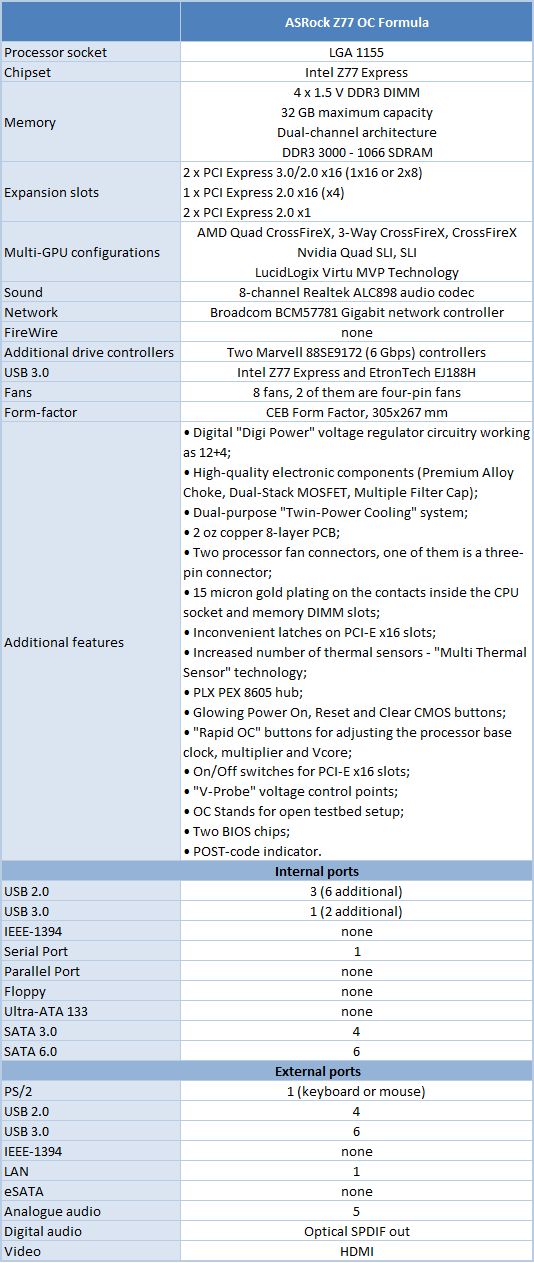
ASRock’s regional web-sites have a product page dedicated to ASRock Z77 OC Formula mainboard, where you can read about its features and functionality, check out its official specifications, download manuals, new BIOS versions, driver and utility updates. Besides, there is also a separate micro-site devoted solely to this mainboard.
BIOS Functionality
We have first discussed ASRock’s new UEFI BIOS in our LGA 2011 mainboard reviews, where we pointed out that their interface seemed very convenient to work with, and the functionality was more than sufficient. After that we discussed their BIOS functionality in our numerous LGA 1155 mainboard reviews. However, the BIOS of ASRock Z77 OC Formula looks completely different, even though it still does have a lot in common with the other versions. For starters, it is not the traditional “Main” section that we see upon entering the BIOS, but “OC Tweaker”, which contains the majority of options for system overclocking and fine-tuning. The interface has also been modified, and now all parameters are displayed against a “starlit sky” background, with twinkling stars.
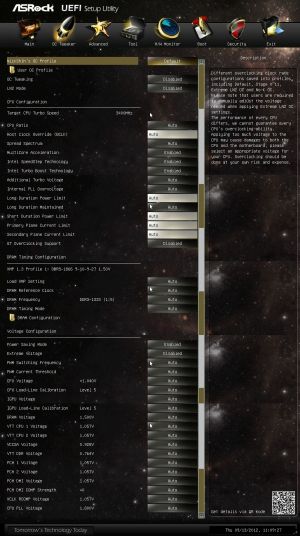
Structurally gigantic page is split into several parts with horizontal lines. The top part is given to profiles and operational modes, then we see a group of parameters related mostly to the processor functionality, then we see options for the memory sub-system configuring, and the last part contains a long list of parameters adjusting the voltages. The voltages may be set above and below the nominal value. They may be set at specific values, or adjusted by adding an offset to the default setting. The current voltages are also displayed right here, next to the corresponding parameters, which is very convenient. The digital voltage regulator circuitry allows selecting Vdroop values for the processor and integrated graphics core.
“Nick Shih’s OC Profile” parameter allows you to overclock your processor automatically, using settings profiles suggested by the overclocking master – Nick Shih.
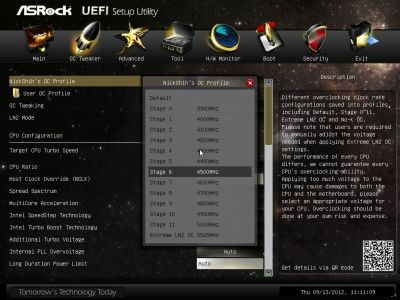
“User OC Profile” sub-section allows saving up to ten BIOS settings profiles instead of three offered by mainstream mainboards. Each profile can have a descriptive name reminding you of the settings in it.
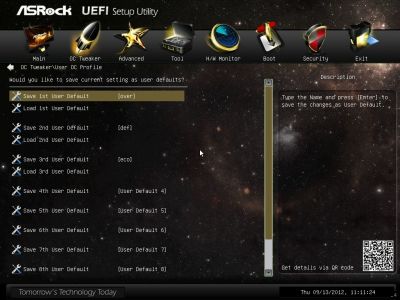
“OC Tweaking” parameter will help you to improve the performance in old but still popular Futuremark benchmarks, especially in 3DMark01. As far as I remember, we saw an undocumented “Legacy BenchMark Enhancement” parameter in Gigabyte mainboards, which most likely has the same effect on the system. It is recommended to enable “LN2 Mode” option if you are using liquid nitrogen cooling. Numerous memory timings may be adjusted in a separate page.
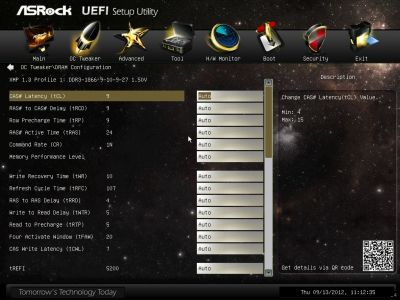
“OC Tweaker” section is displayed when you first access the BIOS, which is quite logical for an overclocker board. However, the “Main” section, reporting the basic system information, allows you to select any BIOS section as your welcome screen.
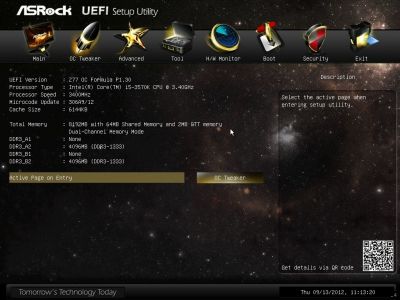
We are already very well familiar with the functionality of the sub-sections in the “Advanced” section: their names speak for themselves.
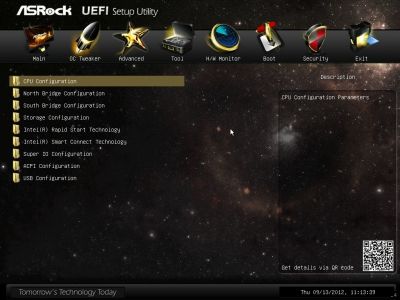
The “CPU Configuration” sub-section contains basic information about the processor and offers to configure some processor technologies.
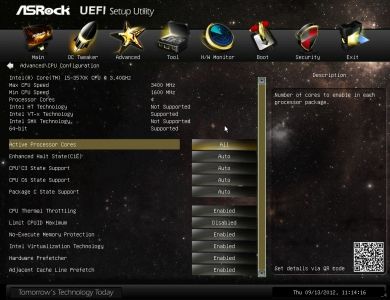
The new “Tool” section contains many features of ASRock mainboards that we are already familiar with as well as a few absolutely new ones. “Dehumidifier Function” will prevent boot-up failures caused by excessive humidity inside the system case. The humidity can be easily lowered from 70% to 40% in a very simple way: by powering the system on from time to time. This function allows setting the frequency of system power-ups, the length of the on-time and the rotation speed of the CPU cooler fan.
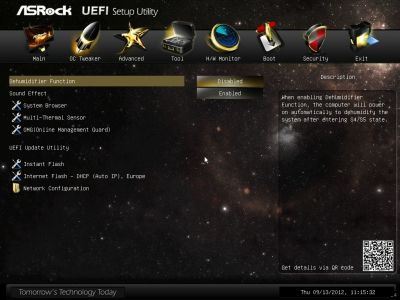
We have already mentioned that every time you enter the BIOS, you hear unique sound effects from the speakers connected to the mainboard. We have come across a similar feature on Intel mainboards, but in ASRock’s case there is no looping of the music, and the sound quality is much better. Moreover, the sound effects accompany navigation across the BIOS sections, a different sound indicates switching between BIOS parameters, and upon selection of a specific value you hear “Select target” voice command. If you feel uneasy when the mainboard talks to you like that, or are tired of repeating sounds, then you can use “Sound Effect” option to turn them off.
“System Browser” sub-section is designed as a pretty precise schematic layout of the board itself. By rolling the mouse pointer over any of the mainboard components on this layout you can get information about it. ASRock OMG (Online Management Guard) function allows denying Internet access at preset times and days of the week in the BIOS.
We are also already familiar with a very convenient BIOS updating tool called “Instant Flash”. This utility will analyze the contents of the plugged in USB drive and provide you a list of compatible updates. All you need to do at this point is select the correct BIOS version. We also noticed a few changes in another even more convenient BIOS updating utility called “Internet Flash”: now we can select the server for downloading the BIOS at the most convenient geographical location.
When we talked about the mainboard functionality, we mentioned “Multi Thermal Sensor” technology – a large number of additional thermal sensors that allow monitoring the temperatures in a variety of PCB spots. The namesake parameter will help identify the location of specific sensors. By rolling the mouse pointer over the sensor name, you can display the corresponding current temperature reading at the bottom.
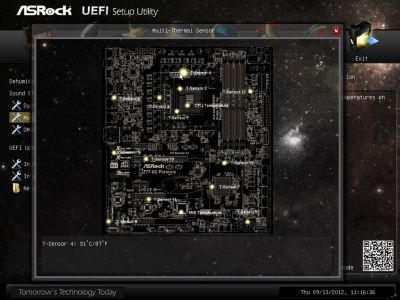
“H/W Monitor” section allows monitoring temperatures, voltages and fan rotation speeds.
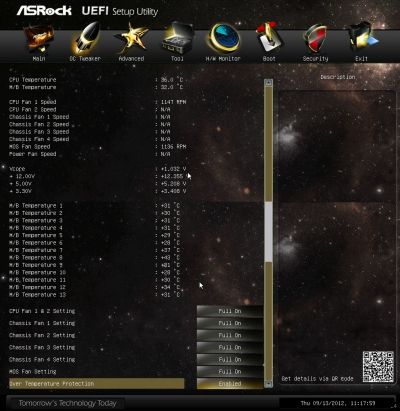
The rotation speeds of the two processor fans and a four-pin system fan may be set in dependence on the temperature or locked at a certain fixed value. The rotation speed of the remaining three system fans and a mainboard cooling system fan can only be lowered to the desired level. Only the “Power FAN” speed can be monitored but cannot be adjusted in any way.
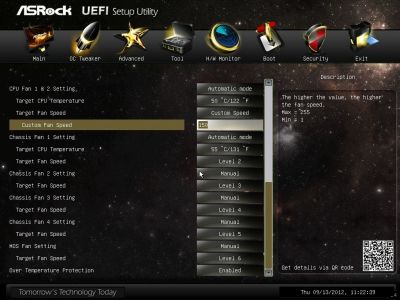
The “Boot” section allows choosing the startup system parameters.
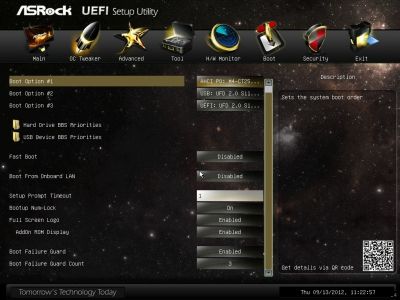
“Security” section will offer to create administrator and user passwords. “Secure Boot” parameter indicates that this mainboard is Microsoft Windows 8 ready.
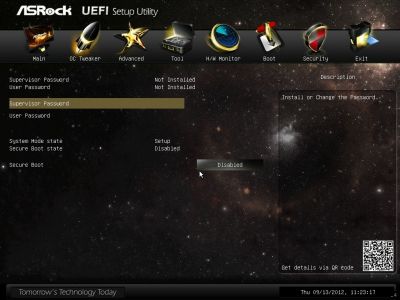
The last section called “Exit” allows you to apply all changes, cancel them or reset all settings to defaults. At any time and in any section you can use F1 key to display the help topics and the list of available hot keys.
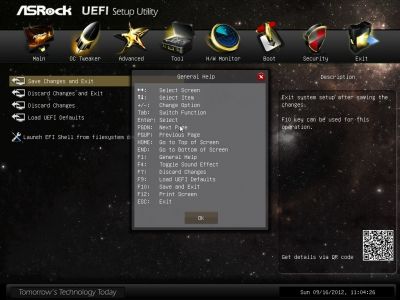
By the way, the QR-code in the right corner of the BIOS screen provides a link to downloading the mainboard manual.
ASRock’s Proprietary Tools and Utilities
In our ASRock Z77 Extreme4 and ASRock Z77 Extreme6 mainboards review we already discussed various aoftware tools bundled with the company’s products. We could mention such goodies as a trial version of Cyberlink MediaEspresso 6.5, and a complete MAGIX Multimedia Suite. It includes “mufin player” audio player, Music Maker Silver program for audio editing, a similar program for video editing called “Video easy SE”, and Photo Manager 10 for image editing. ASRock Z77 OC Formula is bundled with the same software, including such utilities as “Instant Boot”, “XFast USB” and “XFast LAN”. However, instead of a multi-functional “ASRock Extreme Tuning Utility” or a similar “F-Stream” utility that is included with ASRock’s Fatal1ty boards, we find a new program called “Formula Drive” with even more advanced functionality.
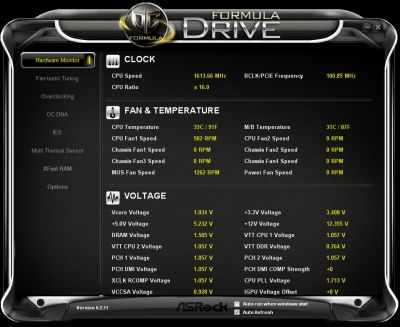
The startup screen is “Hardware Monitor”. It displays information about the system operational characteristics – frequencies, temperatures, fan speeds and voltages. The “Fan-tasting Tuning” tab allows adjusting the rotation speed of the processor and case fans.
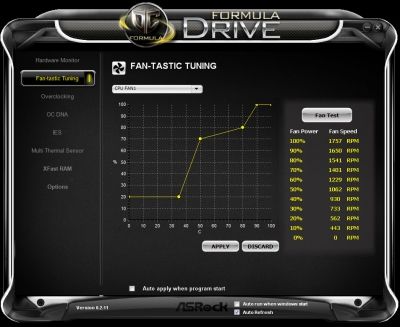
The “Overclocking” tab allows changing base clock frequency, processor clock multiplier and different voltages. Note that there is a scrolling bar on the right-hand side: there are much more voltage-related parameters than you can see on this screenshot.
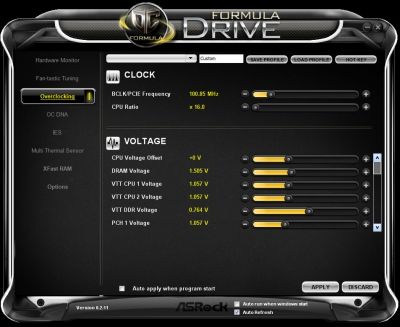
“OC DNA” tab is where you save and exchange BIOS settings profiles.
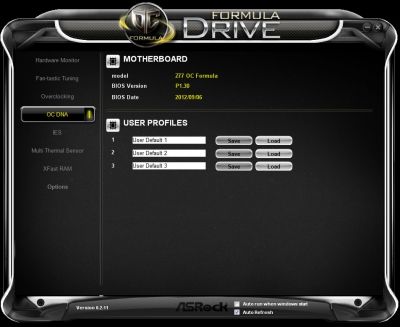
Enabling power-saving in the “IES” (Intelligent Energy Saver) tab will lower the nominal processor Vcore by 0.07 V. however, you should be really careful, because it may in fact, increase the power consumption. The thing is that we may also enable “Power Saving Mode” in the BIOS and it will lower the Vcore by 0.1 V. However, this tab will also prove that the dynamic adjustment of the number of active phases in the processor voltage regulator circuitry works even during overclocking.
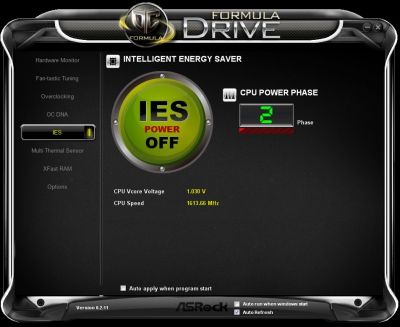
“Multi Thermal Sensor” tab displays the readings taken off numerous thermal sensors.
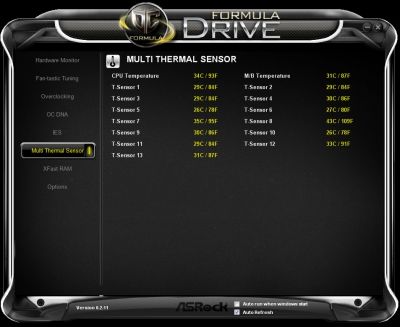
At the same time a window pops up that allows to locate each f the sensors.
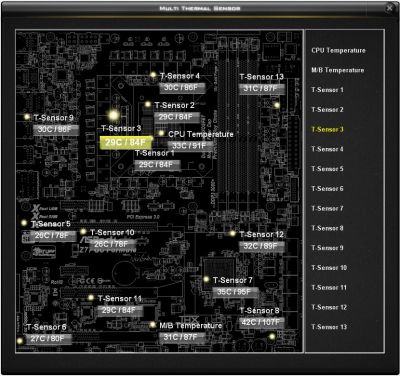
“XFast RAM” tab allows creating a virtual RAM-drive and taking advantage of its functionality.
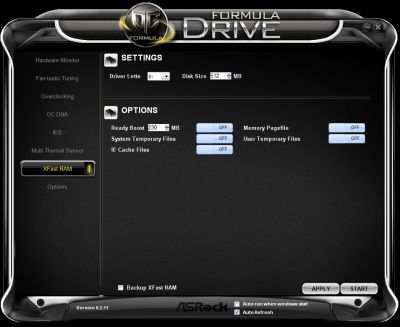
The last “Options” tab offers you to select only those modules of the “Formula Drive” program that you really need.
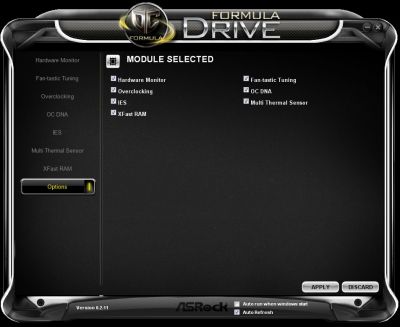
The functionality of “Formula Drive” is truly extensive, but it doesn’t let you adjust the memory timings. In this case you will need “Timing Configurator” utility.
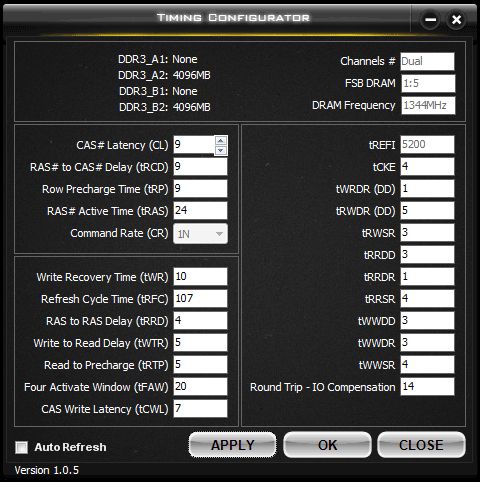
Earlier today we mentioned two “Rapid OC” buttons for changing the base clock, processor frequency multiplier and CPU Vcore on the fly. The “Rapid OC Configuration” utility bundled with ASRock Z77 OC Formula mainboard will help you use these buttons properly. “OC Mode” option selects the parameter to be changed; “Counts on hit” option sets the adjustment increment. You can also set your own “hot” keys, if you like.
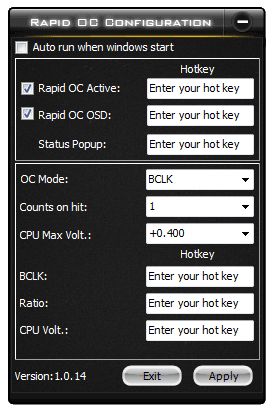
After each parameter change a pop-up window appears where you can see the current values of the parameters you are changing. However, you can disable this window, if you want.
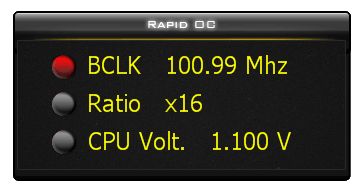
Testbed Configuration
We performed all our tests on a testbed built with the following components:
- Mainboard: ASRock Z77 OC Formula (LGA 1155, Intel Z77 Express, BIOS version 1.30);
- Intel Core i5-3570K CPU (3.6-3.8 GHz, 4 cores, Ivy Bridge rev.E1, 22nm, 77 W, 1.05 V, LGA 1155);
- 2 x 4 GB DDR3 SDRAM Corsair Vengeance CMZ16GX3M4X1866C9R (1866 MHz, 9-10-9-27 timings, 1.5 V voltage);
- Gigabyte GV-T797OC-3GD (AMD Radeon HD 7970, Tahiti, 28 nm, 1000/5500 MHz, 384-bit GDDR5 3072 MB);
- Crucial m4 SSD (CT256M4SSD2, 256 GB, SATA 6 Gbps);
- Scythe Mugen 3 Revision B (SCMG-3100) CPU cooler;
- ARCTIC MX-2 thermal interface;
- Enermax NANX ENM850EWT PSU;
- Open testbed built using Antec Skeleton system case.
We used Microsoft Windows 7 Ultimate SP1 64 bit (Microsoft Windows, Version 6.1, Build 7601: Service Pack 1) operating system, Intel Chipset Software Installation Utility version 9.3.0.1020, AMD Catalyst graphics card driver version 12.4.
Operational and Overclocking Specifics
It has become a common phrase opening this part of our review: the testbed assembly went smoothly and without any problems. And this is indeed the case. Mainboards with out-of-the-ordinary design and inconvenient components layout have become a thing of the past. None of the LGA 1155 mainboards we have reviewed so far caused us any issues during system assembly. When we start the system, we see an unpretentious start-up image with a list of “hot” keys for your convenience. It is really strange that many other mainboard makers still haven’t implemented a little thing like this in their products.
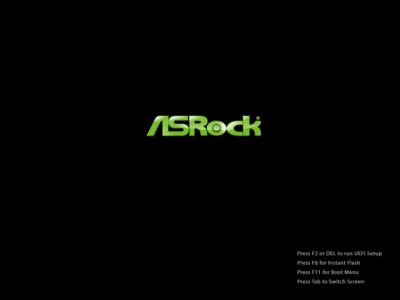
You may turn off the start-up image in the BIOS or by pressing the “Tab” key. In this case we will see the correct processor clock frequency. As for the memory, the board will only display its total size, but not the modules frequency.
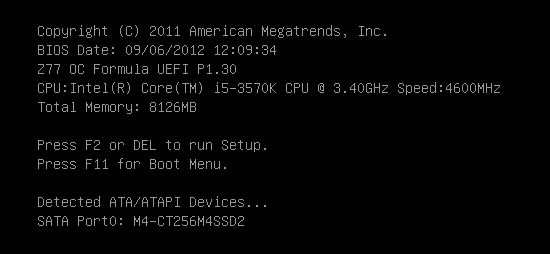
After system assembly, we often say the exact same thing: there were no problems during the system operation in the nominal mode, but some issues popped up during overclocking. However, things were almost the complete opposite of that with ASRock Z77 OC Formula mainboard. Processor and memory overclocking went on flawlessly, but operation in nominal mode revealed a number of unique peculiarities.
We would like to start by saying that there is a “MultiCore Acceleration” parameter in the BIOS, which is enabled by default. Under any type of load this function increases the processor clock frequency multiplier to the maximum value allowed by Intel Turbo Boost, which is intended for single-threaded load types only. This insignificant increase in the processor frequency could be considered acceptable for an overclocker mainboard. However, the “Power Saving Mode” parameter is enabled at the same time, and this one lowers the nominal processor Vcore by 0.1 V. Our ultimate goal during any overclocking experiments is to achieve maximum performance at the minimal possible power consumption, but we carefully test every operational mode for stability. In this particular case, it may be excessively optimistic to have both these parameters are enabled without any stability checks. We believe each non-nominal mode should be selected consciously and not enforced by the manufacturer, and in the nominal mode the system should work the way it is supposed to. However, it isn’t a problem to simply disable “MultiCore Acceleration” and “Power Saving Mode” parameters, which is exactly what we did to ensure that we can have a fair comparison against other mainboards in our performance and power consumption tests. These are definitely not real issues, but merely unique peculiarities, which you should keep in mind, that’s all. However, the real challenges awaited us when we tried to adjust the rotation speed of the CPU fan.
I have to say that almost every mainboard maker out there have their own specific shortcomings, which migrate from one mainboard model to another and are very hard to get rid of for some reason. ASRock mainboards have two of them, and the first one is the incorrectly working Load-Line Calibration technology. We have come across this issue on multiple different models, when the “CPU Load-Line Calibration” parameter is always set to the maximum Vdroop value independent of the settings in the mainboard BIOS. However, this technology worked flawlessly on ASRock Z77 OC Formula, but instead we had a problem with the processor fan rotation speed adjustment. The rotation speed would lower just a tiny bit and barely responded to the BIOS settings, thus generating more noise than desired. At the same time the system took a long time to respond to the changes in the operational load and CPU temperature. If both these parameters increased, the fan would speed up very slowly and then would slow down just as slowly after completion of the tests, when the load and processor temperature dropped.
This isn’t a constructive deficiency, but merely a software flaw, because we discovered that the processor fan speed may be adjusted properly in the “Fan-tasting Tuning” tab of the multifunctional “Formula Drive” utility. Once the calibration is complete, no additional correction is needed, the suggested dependence of the fan speed on the CPU temperature is almost ideal. In idle mode the RPM level is low and the system runs almost completely noiselessly, but it reacts instantaneously to changes in load levels. This could be the case only for some specific fan models, for example for the default four-pin fan of our Scythe Mugen 3 Revision B cooler. However, in the BIOS of Biostar mainboards, for example, we saw the function for calibrating the processor fan, which means that this feature can theoretically be added to ASRock mainboards BIOS, too. Using “Formula Drive” utility resolves this issue, but we would really like to see the rotation speed adjustment feature working properly right from the start.
There is a profile called “Nick Shih’s Profile” in the BIOS of ASRock Z77 OC Formula, which allows you to automatically overclock the processor with a wide variety of frequencies to choose from. The only downsides are that the proposed operation modes suite well for determining the processor’s overclocking potential or setting overclocking records, but are unfit for long-term use. The processor is constantly under increased voltage, all power-saving technologies are disabled. However, we didn’t have any problems during our processor and memory overclocking experiments, when we increased the processor core voltage in Offset mode, i.e. by adding a necessary value to the nominal setting.
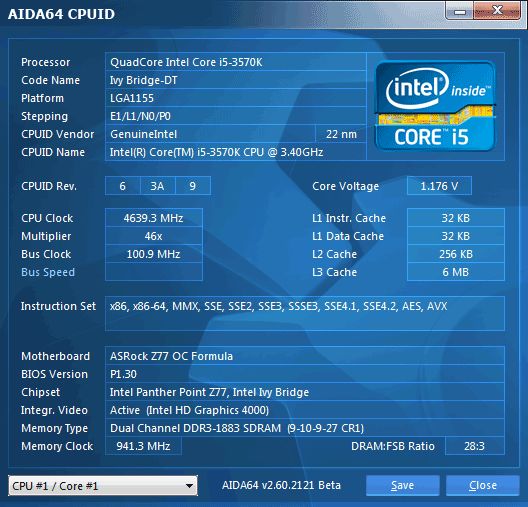
Now I just have to remind you that we always overclock mainboards in such a way that they could be used permanently in this mode. Therefore we do not try to make our life easier by disabling any of the mainboard’s features, e.g. onboard controllers, and try to keep the CPU’s power-saving features up and running. This time we did exactly the same thing. All Intel power-saving technologies remained up and running and automatically lowered the processor Vcore as well as clock frequency multiplier in idle mode.
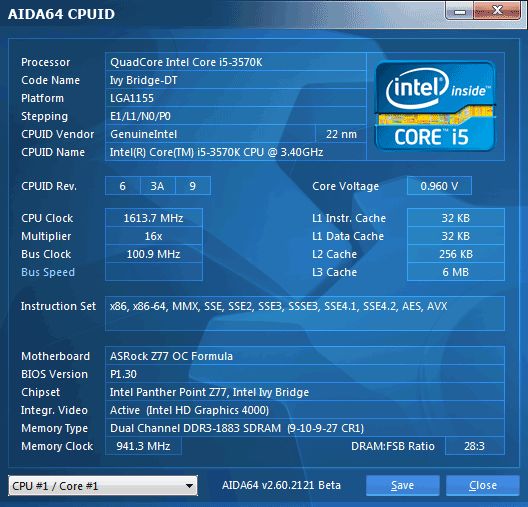
I have to say that we tested ASRock Z77 OC Formula using BIOS version P1.30, but when we completed our tests the new BIOS version P1.40 came out. We checked it out, but didn’t reveal any striking differences from the previous one. The “MultiCore Acceleration” and “Power Saving Mode” parameters are still enabled by default, the adjustment of the processor fan rotation speed is still somewhat flawed.
Performance Comparison
As usual, we are going to compare the mainboards speeds in two different modes: in nominal mode and during CPU and memory overclocking. The first mode is interesting because it shows how well the mainboards work with their default settings. It is a known fact that most users do not fine-tune their systems, they simply choose the optimal BIOS settings and do nothing else. That is why we run a round of tests almost without interfering in any way with the default mainboard settings. For comparison purposes we also included the results of the previously reviewed mainboards:
- ASRock Fatal1ty Z77 Professional
- ASRock Z77 Extreme4 and ASRock Z77 Extreme6
- ASRock Z77 Extreme9
- Asus P8Z77-V Deluxe
- Asus P8Z77-V LX
- Asus Sabertooth Z77
- Gigabyte G1.Sniper 3
- Gigabyte GA-Z77X-UD3H and GA-Z77X-UD5H-WB WIFI
- Gigabyte GA-Z77X-UP4 TH and Gigabyte GA-Z77X-UP5 TH
- Intel DZ77BH-55K
- Intel DZ77GA-70K and Intel DZ77RE-75K
- MSI Z77A-GD65.
The results on the diagrams are sorted out in descending order.
Nominal Mode
We used Cinebench 11.5. All tests were run five times and the average result of the five runs was taken for the performance charts.
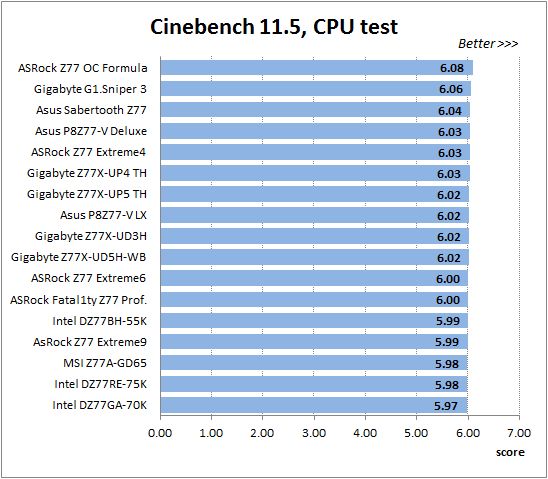
We have been using Fritz Chess Benchmark utility for a long time already and it proved very illustrative. It generated repeated results, the performance in it is scales perfectly depending on the number of involved computational threads.
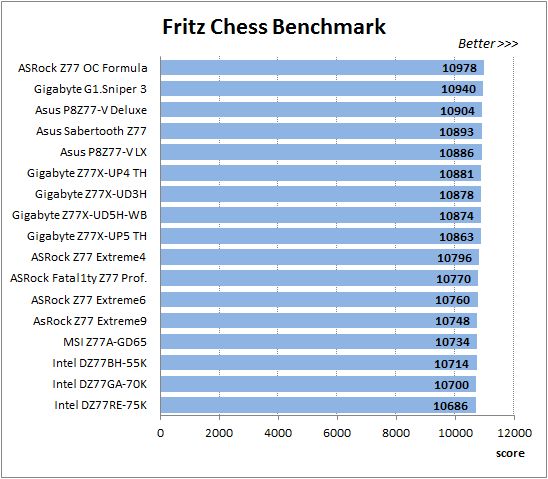
A small video in x264 HD Benchmark 4.0 is encoded in two passes and then the entire process is repeated four times. The average results of the second pass are displayed on the following diagram:
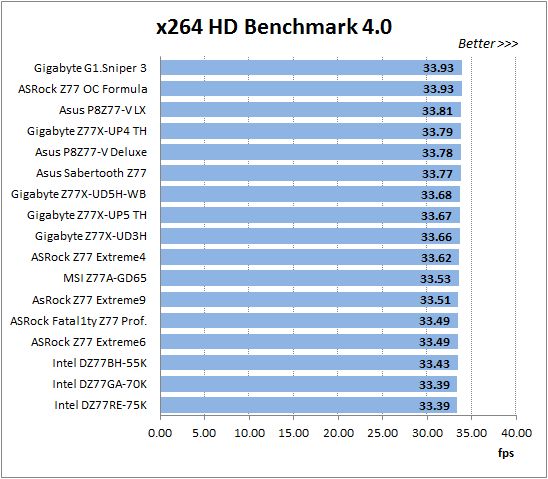
We measured the performance in Adobe Photoshop using our own benchmark made from Retouch Artists Photoshop Speed Test that has been creatively modified. It includes typical editing of four 10-megapixel images from a digital photo camera.
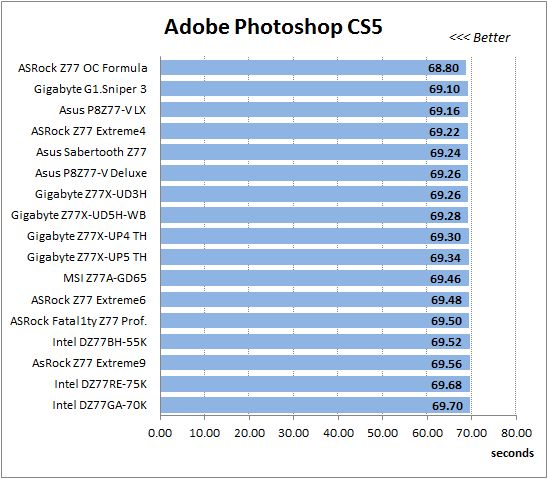
In the archiving test a 1 GB file is compressed using LZMA2 algorithms, while other compression settings remain at defaults.
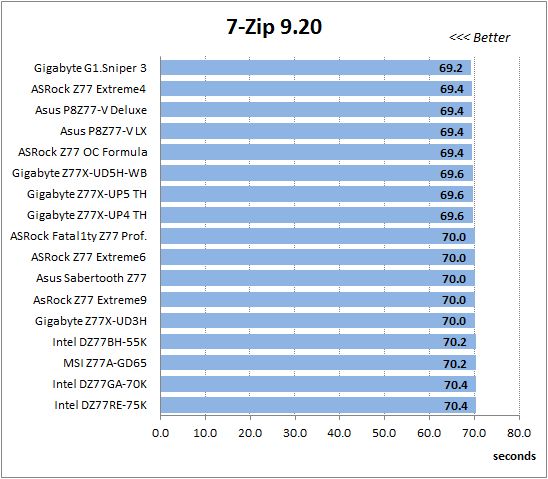
Like in the data compression test, the faster 16 million of Pi digits are calculated, the better. This is the only benchmark where the number of processor cores doesn’t really matter, because it creates single-threaded load.
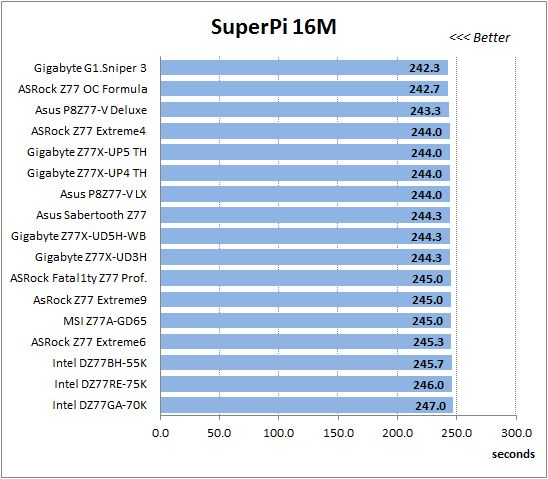
Since we do not overclock graphics in our mainboard reviews, the next diagram shows only CPU tests from the 3DMark11 – Physics Score. This score is obtained in a special physics test that emulates the behavior of a complex gaming system working with numerous objects:
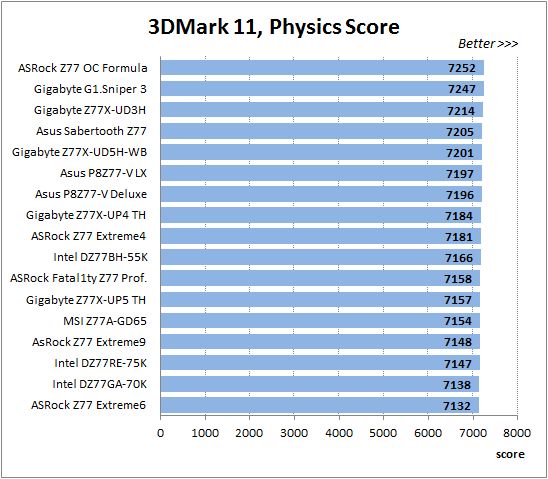
We use FC2 Benchmark Tool to go over Ranch Small map ten times in 1920×1080 resolution with high image quality settings in DirectX 10.
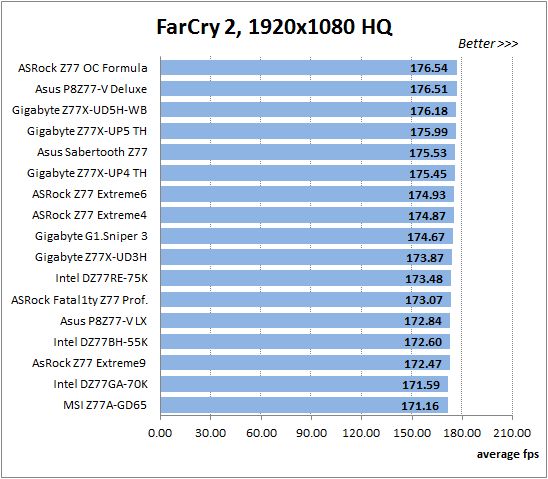
Resident Evil 5 game also has a built-in performance test. Its peculiarity is that it can really take advantage of multi-core processor architecture. The tests were run in DirectX 10 in 1920×1080 resolution with high image quality settings. The average of five test runs was taken for further analysis:
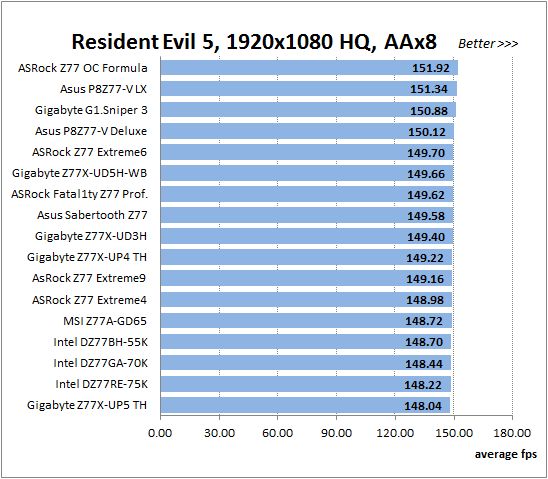
Batman: Arkham City game also reacts eagerly to any changes in the CPU clock frequency, but it uses DirectX 11. We ran game’s integrated benchmark five times with high image quality settings and then take the average of the five runs for the diagrams.
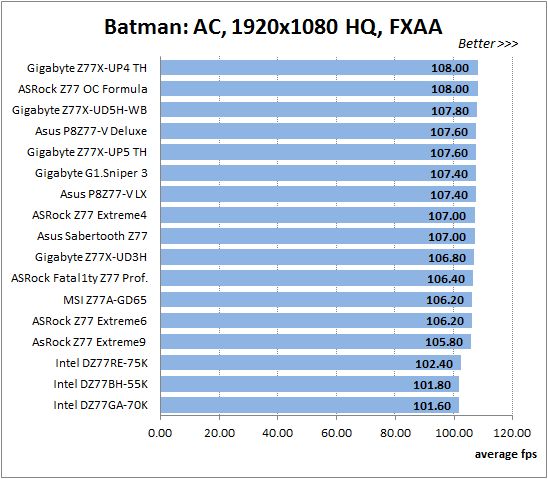
The number of mainboards we tested so far is gradually approaching 20 that is why before starting the tests we decided to highlight ASRock Z77 OC Formula on the diagrams with different color for additional visibility. However, it wasn’t necessary, as the board was always at the top of the charts running either as fast as the fastest of the previously tested mainboards, or demonstrating undefeated maximum performance of all. It is important to keep in mind that in multi-threaded applications this board could outperform all others due to “MultiCore Acceleration” parameter enabled by default, however, we had to ensure that all boards were tested in identical conditions and deprived ASRock Z77 OC Formula of this advantage. Nevertheless, it was still at the top of the charts.
Overclocked Mode
During processor and memory overclocking different mainboard models demonstrated different results. They are summed up in the following table:
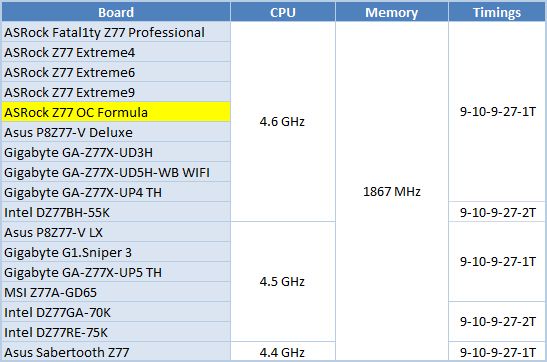
ASRock Z77 OC Formula overclocked the processor to the highest possible level, increased its frequency and configured all necessary memory timings. Taking into account that in equal testing conditions this board turned out the fastest of all we tested, the combination of achievements makes it an undefeated champion in nominal as well as overclocked mode.
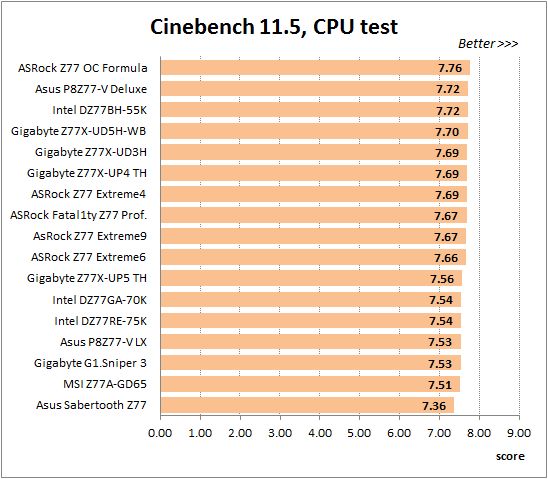
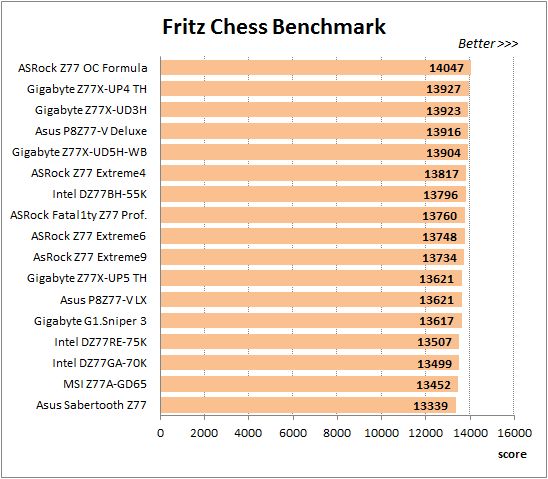
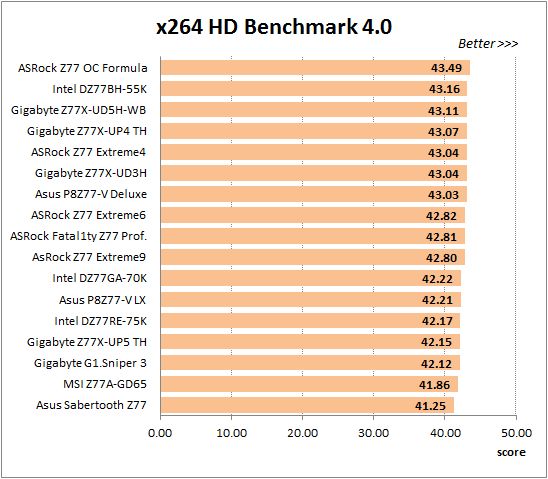
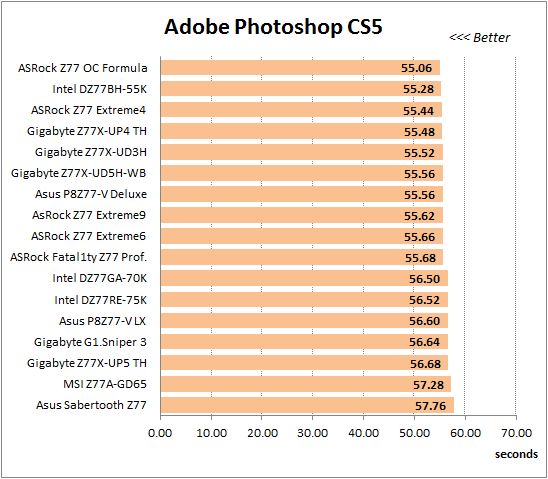
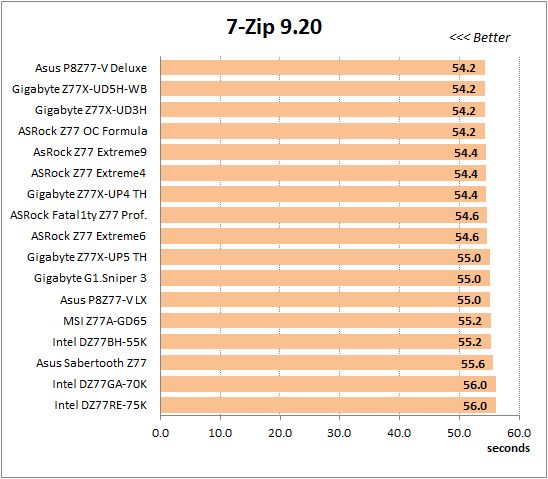
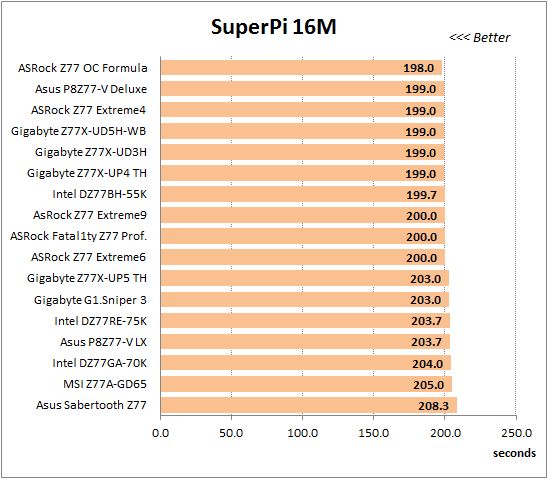
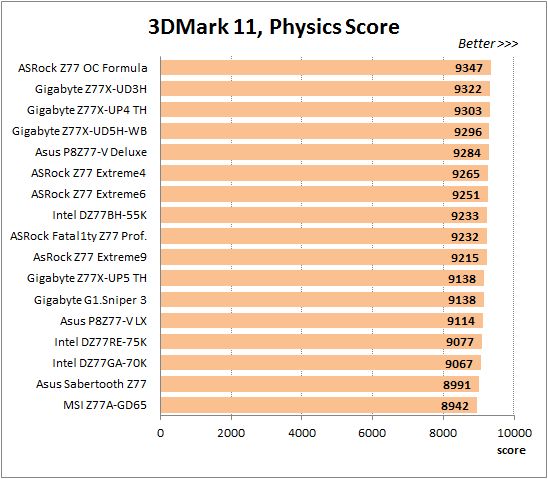
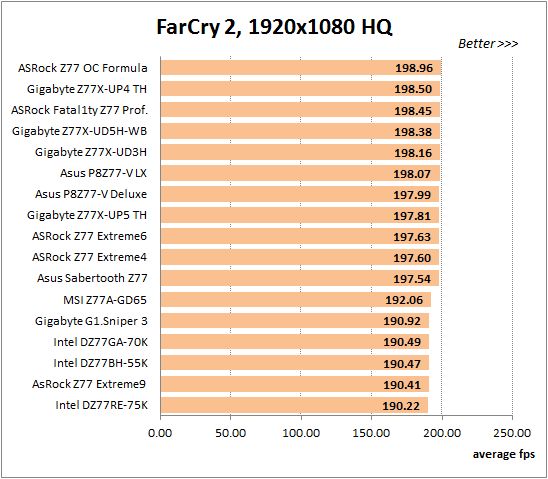
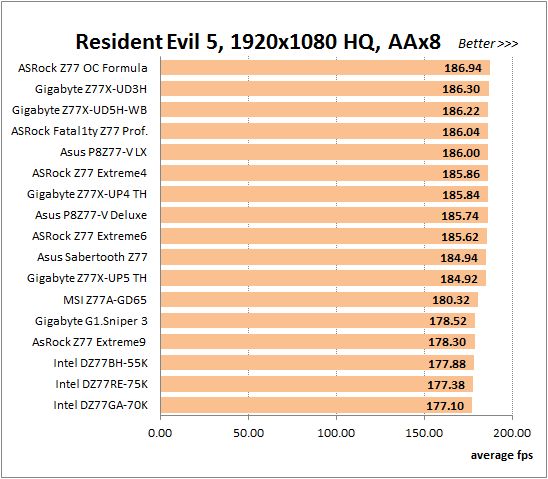
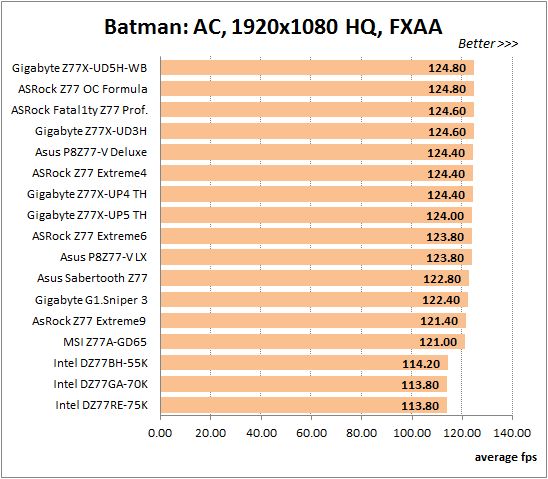
High performance is a very important parameter for a mainboard, but it is really interesting to see what price we have to pay for this success. Let’s take a look at the power consumption tests.
Power Consumption
We performed our power consumption measurements using an Extech Power Analyzer 380803. This device is connected before the PSU and measures the power draw of the entire system (without the monitor), including the power loss that occurs in the PSU itself. In the idle mode we start the system up and wait until it stops accessing the hard disk. Then we use LinX to load the CPU. For a more illustrative picture there are graphs that show how the computer power consumption grows up depending on the number of active execution threads in LinX (both at the default and overclocked system settings).
Because of compatibility issues we uncovered in Gigabyte GA-Z77X-UP4 TH and Gigabyte GA-Z77X-UP5 TH mainboards with our original CoolerMaster RealPower M850 power supply unit, we had to replace it with Enermax NAXN ENM850EW. Both these PSUs have very similar technical characteristics, but Enermax NAXN ENM850EWT is about 1-3 W more energy-efficient than the Cooler Master unit. In order to be able to use the previously obtained results, we decided to make up for this efficiency difference by adding 2 W to all new power readings, so that we could still compare their results against the power consumption of all previously tested products.
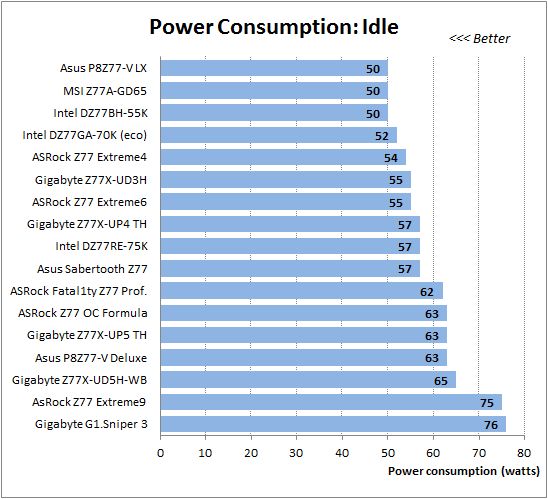
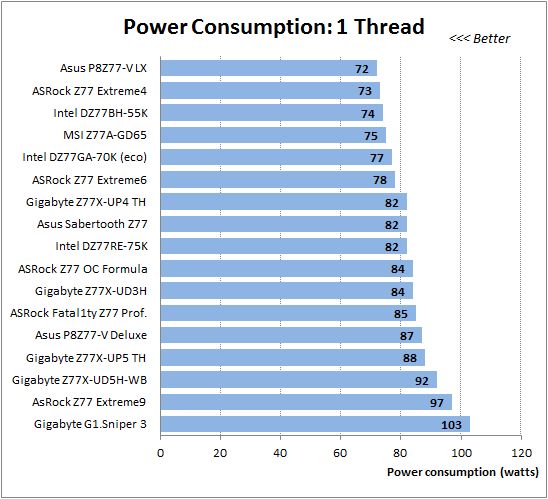
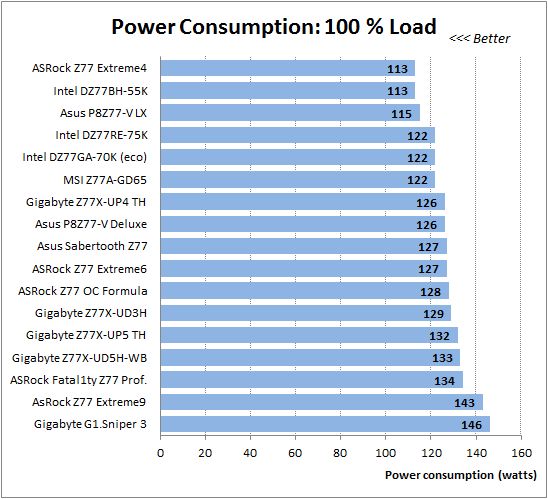
We subconsciously expected ASRock Z77 OC Formula to consume more power than other mainboard models in this review. I am sure you will agree that energy-efficiency is not the primary criterion to consider when designing a mainboard for overclocking and setting records. However, our tests showed that under heavy load the board’s power consumption was at an average level and only in idle mode the board consumed a little more than we had expected. Again, it is important to take into account that we disabled “Power Saving Mode” parameter that lowers the Vcore by 0.1 V to ensure a fair comparison. In any case, enabling this parameter didn’t really affect the mainboard’s power consumption in idle mode, but under load it will be even more energy-efficient in this case.
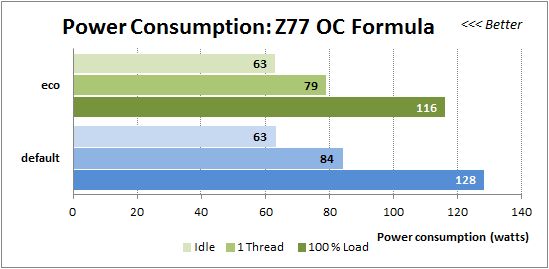
Things do not really change during overclocking. The power consumption of ASRock Z77 OC Formula mainboard in idle mode is above average, and under heavy operational load – on par with other testing participants. Of course, you shouldn’t forget that this board overclocked our test CPU to its absolute maximum, therefore, its power consumption simply can’t be as low as that of the mainboards that didn’t achieve the same overclocking success.
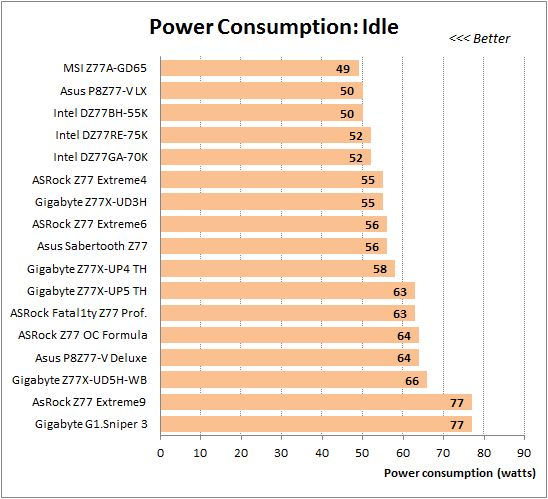
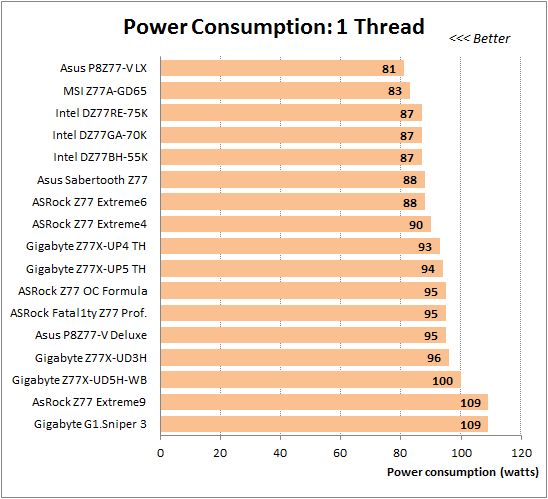
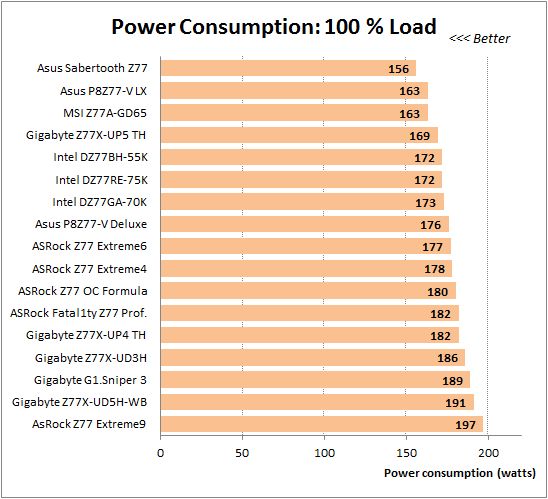
Conclusion
When we started reviewing ASRock Z77 OC Formula mainboard, we weren’t prejudiced against it. ASRock mainboards are currently among the best in the market, but we were still somewhat alerted, to be honest. We have been witness to several situations when the manufacturer’s intention to stand out and load their product with everything at once (and more than the competition has) had a negative outcome. They would come up with a multi-functional model, but most of these features would be very difficult to work with, and some of them would be absolutely unnecessary for the majority of users being none other but a fantasy of the marketing folks. Luckily, this isn’t the case with ASRock Z77 OC Formula. When some users hear that it is a mainboard for overclocking and records, they may feel that it isn’t a good choice for them since they are not interested in setting records or overclocking their system, and may decide to look for something simpler. Wrong decision! ASRock Z77 OC Formula is not a specific or very niche product that will be of interest to very few professionals out there, but an absolutely normal mainboard with excellent functionality, rich accessories bundle and excellent electron components base. If at some point you decide to give it a shot in the overclocking community, you will have all the richest functionality at your fingertips. Yes, you will have to pay for superb additional features, but even though this mainboard is priced above average, the price is still quite reasonable. This board is fast, relatively energy-efficient, almost completely flawless and boasts a ton of indisputable advantages. If I were to describe this product with one phrase I would say: this is the mainboard I want for my system.
That said we are proud to award ASRock Z77 OC Formula our highest title – Editor’s Choice:
